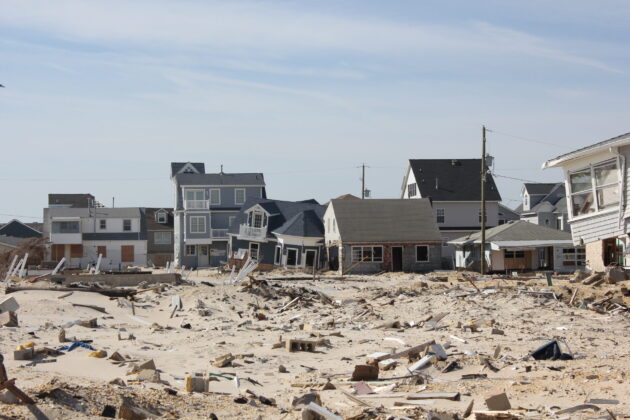According to national experts, it can take 5-10 years, or more, for hard-hit communities to fully recover from disasters and develop a new sense of “normal.”
With just a year after Sandy, it’s understandable, and expected, that many New Jersey communities are still in the early stages of recovery, facing such fundamental problems as displaced residents, the loss of homes and businesses, a significant decline in tax revenue, large infrastructure expenses, and the list goes on.
Unfortunately, for some towns, the full extent of recovery problems has yet to be revealed, a process that experts refer to as “cascading,” or the gradual unfolding of issues unique to a disaster.
Financial and technical assistance continues to be available to Sandy-impacted communities from government and non-governmental resource providers. But the complexity of local recovery, combined with the limited capacity and resources of the municipalities, has made the mere act of locating the “right” assistance a challenge in itself.
Resource providers – particularly non-governmental organizations – are experiencing a similar problem. With hundreds of individual municipalities having suffered storm damage, it’s been difficult finding, and prioritizing, communities that would benefit from their services.
The Resilency Network
To respond to these circumstances, Sustainable Jersey and a number of other partners have joined forces to establish The Resiliency Network as a means to link municipalities with the tools and assistance they need for long-term recovery and resiliency, and to coordinate between different organizations public, private, state, federal, to ensure that limited resources are being applied in the most efficient and effective way.
As facilitator of The Resiliency Network, Sustainable Jersey will work directly with communities to identify unmet recovery needs and match them up with resource providers who can provide much needed services. Sustainable Jersey will also serve as a liaison between communities and the new Network Advisory Group, who will be analyzing community recovery progress, and recommending new tools, research and strategies to move communities closer to resiliency.
Central Source of Community Resources
One of the most important features of The Resiliency Network will be an online, central database of financial and technical resources for communities. While the majority of state and federal grants are relatively easy to locate on government websites, it can be difficult to identify grants that are attainable and worth the investment of time to apply.
Technical assistance from government and non-governmental organizations is even more difficult to find, either because the services are limited, or the programs are not specifically tied to a Sandy-recovery program. For example, downtown revitalization expertise, floodplain ordinance templates, university planning studios, fiscal budgeting projections, and hazard mitigation planning, are just some of the many types of free assistance offered by agencies and organizations in New Jersey, though they can’t easily be found through an Internet search or website. Sustainable Jersey is compiling these resources into a central database, and will continue to meet with organizations and agencies to expand their services as unmet needs are revealed.
Matching Needs to Resources
With support from a network of resource providers and their services, Sustainable Jersey will deploy circuit riders (or staff) to meet with communities to discuss their stage of recovery and the range of resources available through the Network. Based upon these discussions, the circuit riders may provide direct assistance with small, targeted projects, or, connect the community with a resource provider that can provide the desired services.
Also working directly with communities are recovery managers, who are embedded in towns for an extended period of time to assist in the development and implementation of recovery plans. New Jersey Future, one of the Network’s resource providers, has deployed three recovery managers covering 8-10 communities in Monmouth, Ocean and Cumberland Counties, all of which will have the same access to the Network’s resources. The circuit riders and recovery managers will meet regularly to share their experiences and report their findings to the Network staff and the new Network Advisory Board.
Improving Tools for Community Recovery and Resiliency
The Resiliency Network will have an Advisory Board that will provide an important opportunity to respond to real time, on-the-ground issues and needs with new research, tools and programs. Both the recovery managers and circuit riders will report frequently on community recovery progress, and apprise the Board of issues and gaps in available resources.
The Board will also monitor the progress of community recovery through community forums and idea exchanges, where local officials and other stakeholders can present their issues and concerns. Comprised of a multi-disciplinary group of professionals and community officials, and staffed by Sustainable Jersey, the Network Advisory Board will have the knowledge and expertise to generate best practices for recovery and resiliency in the form of new local, state and national policies and practices.
Sustainable Jersey will further assist with the implementation of these practices by converting them into municipal “actions” and guidance manuals and providing incentives for communities to adopt them through the successful Sustainable Jersey certification program.
For more about Sustainable Jersey®:
Website | Facebook | Twitter
Linda Weber is a professional planner with over 25 years of municipal planning experience in the public and private sectors. She recently served as a Community Recovery Specialist with the Federal Emergency Management Agency (FEMA) and is currently the Sustainable Jersey Network Resiliency Manager. Linda is the Chair of the American Planning Association-NJ Hazard Mitigation and Recovery Planning Committee and served as a member of the Urban Land Use Institute Hurricane Sandy Task Force.


